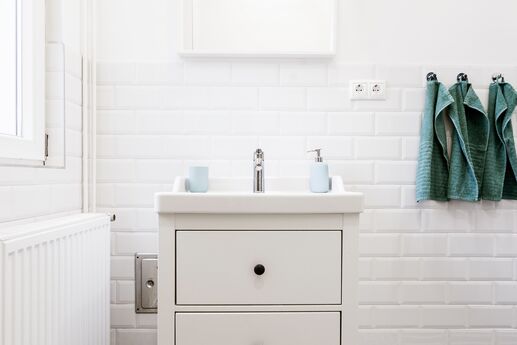
At some point or another, you’ll need to do a bathroom renovation. Fixtures get outdated and leaky, colors and materials go out of style, and simple wear and tear on this oft-used room makes renovation necessary. Remodeling a bathroom can add value to your home, as well as make life easier for you and your family. Whether doing a gut renovation or just updating your fixtures and hardware, you’ll need to develop a plan of attack — and we’re here to help.
Logistics
A bathroom remodel is not something you should do on a whim. You need to create a scope for the project; what needs to be done and on what date. You’ll also need to prioritize what absolutely needs to be replaced and which items can wait. Finally, be honest with yourself about what you can do yourself, and when you should bring in a contractor.
Since toilet, sinks and showers are a daily necessity, you’re going to need to figure out how your family is going to function during the project. Full-scale renovations can take two to three months, so the ideal scenario would be for you to have another functioning bathroom in the house. If you don’t, plan the renovation around your family’s needs, and find another place to stay if the toilet and tub are going to be out of commission for more than one working day.
If you’re hiring a contractor for the job, keep in mind:
- Keep your kids safe by making storage areas for power tools, keeping exposed wires and sharp objects hidden or behind closed doors, and finding activities for them outside of the house while work is being done.
- Establish rules with contractors about what they are and are not allowed to do in your home, i.e. smoking, playing music, cleaning up, etc.
Budgets and deadlines
Once you have a list of what you’d like to remodel, create a budget that you can stick to. To avoid money stress, create a margin of error for at least a 10 percent increase. A bathroom remodel is an investment, so if you are planning on moving within a few years, your remodel — at the low end — should comprise 5 percent of your home’s value. On the higher end, it should represent 10 percent. If, however, you are staying in this home for the long haul, plan to spend enough to keep your family comfortable for years.
To save on your remodel, don’t mess with the plumbing. Simply replacing fixtures instead of re-organizing the room will save you big bucks in labor costs. Of course, sometimes this can’t be avoided — if you have an old home with an untenable layout, or the plumbing or wiring are fraying or leaking and need to be replaced, make sure you leave plenty of room in your budget for unexpected expenses that lurk behind walls.
Use a spreadsheet or budgeting software, like Quicken or Mint, to keep track of actual vs. budgeted expenses and stay on track. You may find a little extra money in the end for something special.
Make a detailed plan and timeline before you start. This will establish deadlines and costs that you (or your contractor) can stick to. It’s also a good idea to wait until all of your materials arrive before starting renovations. You don’t want to be stuck waiting for a material with your bathroom torn to pieces.
Going Green
Consider green products, like a low-flow shower or toilet. A low-flow toilet can save you up to $100 a year on your water bill, without sacrificing flushing power. A low-flow showerhead will also save you money on water and heating costs. To determine whether you would benefit from a low-flow showerhead, place a bucket (marked in gallons) under your shower head and time how long it takes to fill one gallon of water. If it takes less than 20 seconds, you could benefit from a low-flow showerhead. There are also numerous flooring options — such as Linoleum — which are green and affordable.
